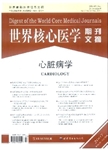急性肺水肿伴急性冠状动脉综合征患者的30d预后
Thirty day prognosis of patients with acute pulmonary oedema complicating acute coronary syndromes作者机构:Unitat Coron■ria Hospital General Universitari d'Hebron Universitat Autònoma de Barcelona P Vall d'Hebron 119-129 08035 Barcelona Spain
出 版 物:《世界核心医学期刊文摘(心脏病学分册)》 (Digest of the World Core Medical Journals(Cardiology))
年 卷 期:2005年第1卷第12期
页 面:48-49页
学科分类:1002[医学-临床医学] 100201[医学-内科学(含:心血管病、血液病、呼吸系病、消化系病、内分泌与代谢病、肾病、风湿病、传染病)] 10[医学]
主 题:不稳定型心绞痛 射血分数 多支血管病变 收缩功能 慢性高血压 三级护理 老年高血压 峰值浓度 舒张期 二尖瓣反流
摘 要:Objectives: To investigate the characteristics of the acute coronary syndromes underlying acute pulmonary oedema and their 30 day prognosis. Patients: 185 consecutive patients with acute coronary syndromes and acute pulmonary oedema admitted to a tertiary care centre. Main outcome and measures: Clinical, ECG, echocardiographic, enzymatic, and angiographic features were prospectively investigated. Results: Non-ST segment elevation myocardial infarction(NSTEMI) was the most frequent cause of acute pulmonary oedema(61%) followed by unstable angina(UA; 21%) and ST segment elevation myocardial infarction(STEMI; 18%). In each group, mean age was ≥70 years, but NSTEMI patients were the oldest and ≥65%of patients had chronic hypertension. Moreover, patients with NSTEMI and UA were older and had a higher incidence of diabetes, previous myocardial infarction, and moderate to severe mitral regurgitation but a similarly reduced ejection fraction(NSTEMI, 41%; UA, 39%; and STEMI, 39%) and increased incidence of diastolic dysfunction and rate of multivessel disease(94%, 87%, and 86%, respectively). However, patients with STEMI had a higher creatine kinase MB peak concentration(158 v 76 μg/l in the NSTEMI group, p100 μg/l as the main prognostic markers(p 0.03). Conclusions: Acute pulmonary oedema is mostly a complication of elderly hypertensive patients with NSTEMI or UA(82%) and with multivessel disease often associated with mitral regurgitation. On the other hand, the larger infarct size and higher mortality in patients with STEMI with a similarly reduced ejection fraction suggest a more extensive acute systolic loss.



